Antonio Vergari
Neurosymbolic Reasoning Shortcuts under the Independence Assumption
Jul 15, 2025Abstract:The ubiquitous independence assumption among symbolic concepts in neurosymbolic (NeSy) predictors is a convenient simplification: NeSy predictors use it to speed up probabilistic reasoning. Recent works like van Krieken et al. (2024) and Marconato et al. (2024) argued that the independence assumption can hinder learning of NeSy predictors and, more crucially, prevent them from correctly modelling uncertainty. There is, however, scepticism in the NeSy community around the scenarios in which the independence assumption actually limits NeSy systems (Faronius and Dos Martires, 2025). In this work, we settle this question by formally showing that assuming independence among symbolic concepts entails that a model can never represent uncertainty over certain concept combinations. Thus, the model fails to be aware of reasoning shortcuts, i.e., the pathological behaviour of NeSy predictors that predict correct downstream tasks but for the wrong reasons.
SEMMA: A Semantic Aware Knowledge Graph Foundation Model
May 26, 2025Abstract:Knowledge Graph Foundation Models (KGFMs) have shown promise in enabling zero-shot reasoning over unseen graphs by learning transferable patterns. However, most existing KGFMs rely solely on graph structure, overlooking the rich semantic signals encoded in textual attributes. We introduce SEMMA, a dual-module KGFM that systematically integrates transferable textual semantics alongside structure. SEMMA leverages Large Language Models (LLMs) to enrich relation identifiers, generating semantic embeddings that subsequently form a textual relation graph, which is fused with the structural component. Across 54 diverse KGs, SEMMA outperforms purely structural baselines like ULTRA in fully inductive link prediction. Crucially, we show that in more challenging generalization settings, where the test-time relation vocabulary is entirely unseen, structural methods collapse while SEMMA is 2x more effective. Our findings demonstrate that textual semantics are critical for generalization in settings where structure alone fails, highlighting the need for foundation models that unify structural and linguistic signals in knowledge reasoning.
Neurosymbolic Diffusion Models
May 19, 2025Abstract:Neurosymbolic (NeSy) predictors combine neural perception with symbolic reasoning to solve tasks like visual reasoning. However, standard NeSy predictors assume conditional independence between the symbols they extract, thus limiting their ability to model interactions and uncertainty - often leading to overconfident predictions and poor out-of-distribution generalisation. To overcome the limitations of the independence assumption, we introduce neurosymbolic diffusion models (NeSyDMs), a new class of NeSy predictors that use discrete diffusion to model dependencies between symbols. Our approach reuses the independence assumption from NeSy predictors at each step of the diffusion process, enabling scalable learning while capturing symbol dependencies and uncertainty quantification. Across both synthetic and real-world benchmarks - including high-dimensional visual path planning and rule-based autonomous driving - NeSyDMs achieve state-of-the-art accuracy among NeSy predictors and demonstrate strong calibration.
Scalable Expectation Estimation with Subtractive Mixture Models
Mar 27, 2025Abstract:Many Monte Carlo (MC) and importance sampling (IS) methods use mixture models (MMs) for their simplicity and ability to capture multimodal distributions. Recently, subtractive mixture models (SMMs), i.e. MMs with negative coefficients, have shown greater expressiveness and success in generative modeling. However, their negative parameters complicate sampling, requiring costly auto-regressive techniques or accept-reject algorithms that do not scale in high dimensions. In this work, we use the difference representation of SMMs to construct an unbiased IS estimator ($\Delta\text{Ex}$) that removes the need to sample from the SMM, enabling high-dimensional expectation estimation with SMMs. In our experiments, we show that $\Delta\text{Ex}$ can achieve comparable estimation quality to auto-regressive sampling while being considerably faster in MC estimation. Moreover, we conduct initial experiments with $\Delta\text{Ex}$ using hand-crafted proposals, gaining first insights into how to construct safe proposals for $\Delta\text{Ex}$.
A Probabilistic Neuro-symbolic Layer for Algebraic Constraint Satisfaction
Mar 25, 2025Abstract:In safety-critical applications, guaranteeing the satisfaction of constraints over continuous environments is crucial, e.g., an autonomous agent should never crash into obstacles or go off-road. Neural models struggle in the presence of these constraints, especially when they involve intricate algebraic relationships. To address this, we introduce a differentiable probabilistic layer that guarantees the satisfaction of non-convex algebraic constraints over continuous variables. This probabilistic algebraic layer (PAL) can be seamlessly plugged into any neural architecture and trained via maximum likelihood without requiring approximations. PAL defines a distribution over conjunctions and disjunctions of linear inequalities, parameterized by polynomials. This formulation enables efficient and exact renormalization via symbolic integration, which can be amortized across different data points and easily parallelized on a GPU. We showcase PAL and our integration scheme on a number of benchmarks for algebraic constraint integration and on real-world trajectory data.
COPA: Comparing the Incomparable to Explore the Pareto Front
Mar 18, 2025



Abstract:In machine learning (ML), it is common to account for multiple objectives when, e.g., selecting a model to deploy. However, it is often unclear how one should compare, aggregate and, ultimately, trade-off these objectives, as they might be measured in different units or scales. For example, when deploying large language models (LLMs), we might not only care about their performance, but also their CO2 consumption. In this work, we investigate how objectives can be sensibly compared and aggregated to navigate their Pareto front. To do so, we propose to make incomparable objectives comparable via their CDFs, approximated by their relative rankings. This allows us to aggregate them while matching user-specific preferences, allowing practitioners to meaningfully navigate and search for models in the Pareto front. We demonstrate the potential impact of our methodology in diverse areas such as LLM selection, domain generalization, and AutoML benchmarking, where classical ways to aggregate and normalize objectives fail.
On Faster Marginalization with Squared Circuits via Orthonormalization
Dec 10, 2024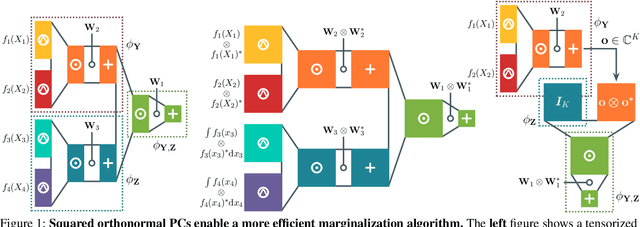

Abstract:Squared tensor networks (TNs) and their generalization as parameterized computational graphs -- squared circuits -- have been recently used as expressive distribution estimators in high dimensions. However, the squaring operation introduces additional complexity when marginalizing variables or computing the partition function, which hinders their usage in machine learning applications. Canonical forms of popular TNs are parameterized via unitary matrices as to simplify the computation of particular marginals, but cannot be mapped to general circuits since these might not correspond to a known TN. Inspired by TN canonical forms, we show how to parameterize squared circuits to ensure they encode already normalized distributions. We then use this parameterization to devise an algorithm to compute any marginal of squared circuits that is more efficient than a previously known one. We conclude by formally showing the proposed parameterization comes with no expressiveness loss for many circuit classes.
Is Complex Query Answering Really Complex?
Oct 16, 2024


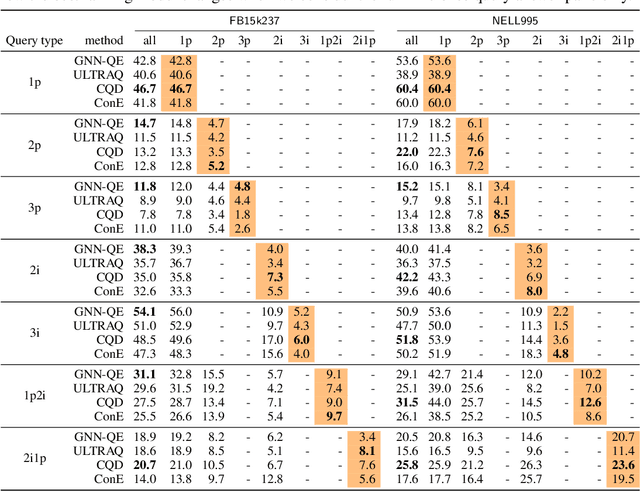
Abstract:Complex query answering (CQA) on knowledge graphs (KGs) is gaining momentum as a challenging reasoning task. In this paper, we show that the current benchmarks for CQA are not really complex, and the way they are built distorts our perception of progress in this field. For example, we find that in these benchmarks, most queries (up to 98% for some query types) can be reduced to simpler problems, e.g., link prediction, where only one link needs to be predicted. The performance of state-of-the-art CQA models drops significantly when such models are evaluated on queries that cannot be reduced to easier types. Thus, we propose a set of more challenging benchmarks, composed of queries that require models to reason over multiple hops and better reflect the construction of real-world KGs. In a systematic empirical investigation, the new benchmarks show that current methods leave much to be desired from current CQA methods.
What is the Relationship between Tensor Factorizations and Circuits (and How Can We Exploit it)?
Sep 12, 2024



Abstract:This paper establishes a rigorous connection between circuit representations and tensor factorizations, two seemingly distinct yet fundamentally related areas. By connecting these fields, we highlight a series of opportunities that can benefit both communities. Our work generalizes popular tensor factorizations within the circuit language, and unifies various circuit learning algorithms under a single, generalized hierarchical factorization framework. Specifically, we introduce a modular "Lego block" approach to build tensorized circuit architectures. This, in turn, allows us to systematically construct and explore various circuit and tensor factorization models while maintaining tractability. This connection not only clarifies similarities and differences in existing models, but also enables the development of a comprehensive pipeline for building and optimizing new circuit/tensor factorization architectures. We show the effectiveness of our framework through extensive empirical evaluations, and highlight new research opportunities for tensor factorizations in probabilistic modeling.
Sum of Squares Circuits
Aug 21, 2024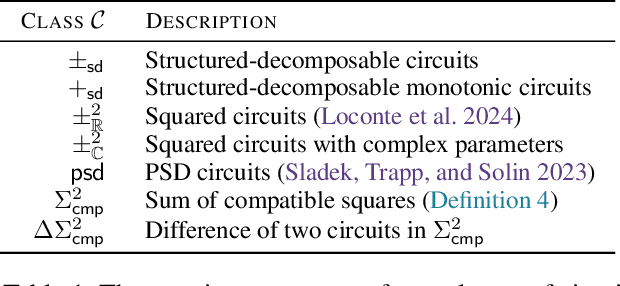
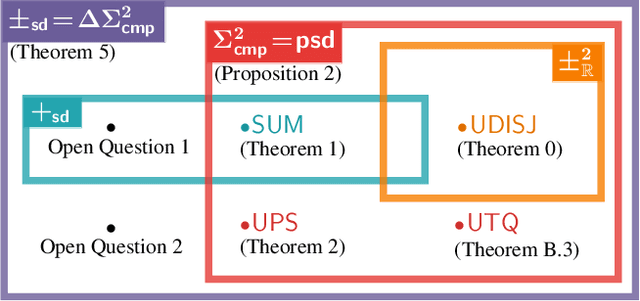
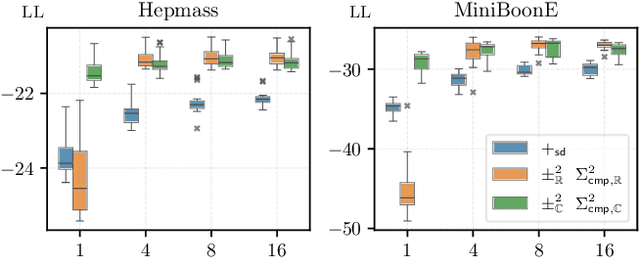
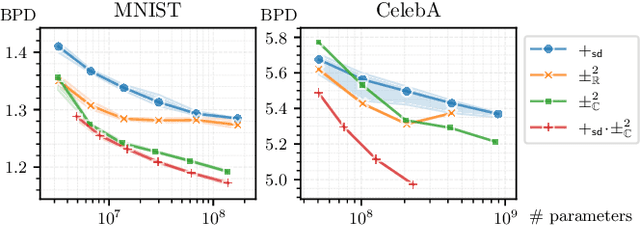
Abstract:Designing expressive generative models that support exact and efficient inference is a core question in probabilistic ML. Probabilistic circuits (PCs) offer a framework where this tractability-vs-expressiveness trade-off can be analyzed theoretically. Recently, squared PCs encoding subtractive mixtures via negative parameters have emerged as tractable models that can be exponentially more expressive than monotonic PCs, i.e., PCs with positive parameters only. In this paper, we provide a more precise theoretical characterization of the expressiveness relationships among these models. First, we prove that squared PCs can be less expressive than monotonic ones. Second, we formalize a novel class of PCs -- sum of squares PCs -- that can be exponentially more expressive than both squared and monotonic PCs. Around sum of squares PCs, we build an expressiveness hierarchy that allows us to precisely unify and separate different tractable model classes such as Born Machines and PSD models, and other recently introduced tractable probabilistic models by using complex parameters. Finally, we empirically show the effectiveness of sum of squares circuits in performing distribution estimation.
 Add to Chrome
Add to Chrome Add to Firefox
Add to Firefox Add to Edge
Add to Edge